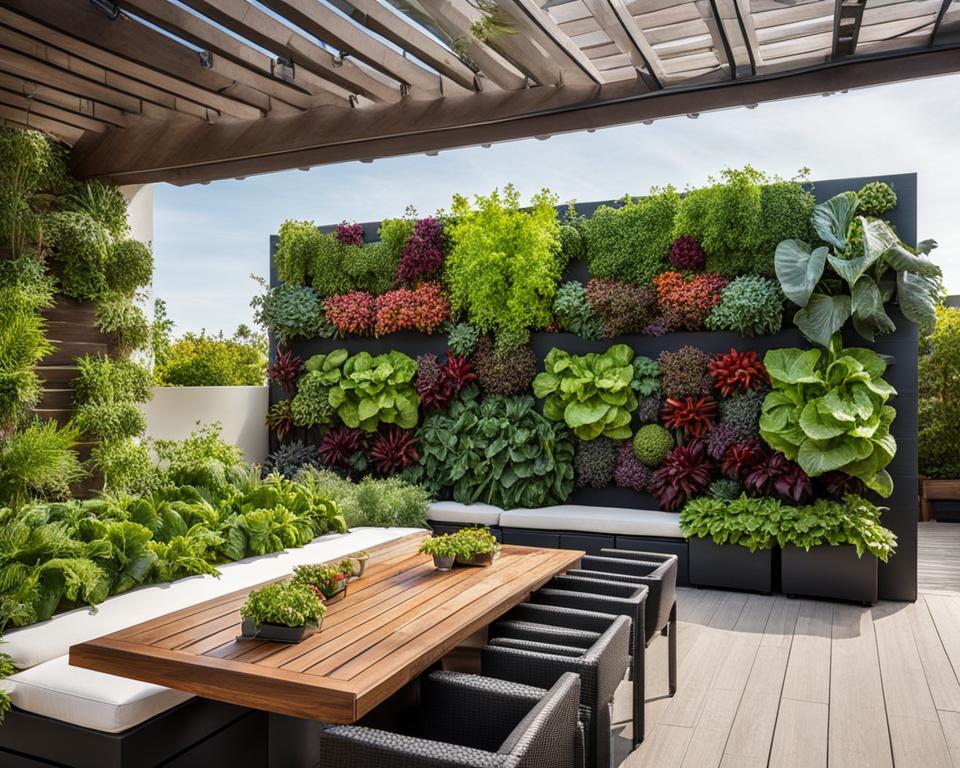Welcome to my article on the incredible benefits of vertical vegetable gardening systems. If you’re looking to maximize space utilization and create a lush green space in limited garden areas or urban environments, vertical gardening is the perfect solution for you. This unique gardening technique involves growing plants vertically on walls, fences, or specially designed structures. Not only does it optimize space efficiency, but it also offers a wide range of advantages both for you and the environment.
Key Takeaways:
- Vertical gardening maximizes space efficiency, making it ideal for individuals with limited garden areas or small outdoor spaces.
- By growing plants vertically, you can increase your yield in limited space and enjoy a bountiful harvest.
- Vertical gardens add aesthetic appeal, providing a stunning visual element and creating a sense of tranquility and natural beauty.
- They contribute to better air quality by acting as natural air purifiers, promoting a cleaner and fresher atmosphere.
- Vertical gardens offer insulation benefits, reducing heat gain in summers and heat loss in winters, leading to enhanced energy efficiency.
The Concept of Vertical Gardening
Vertical gardening is a revolutionary approach to growing plants that involves maximizing space by growing plants vertically. It can be done on walls, fences, or specially designed structures and is ideal for individuals with limited garden areas or those living in urban environments. Vertical gardening offers a sustainable and aesthetically pleasing way to create lush green spaces even in small or restricted outdoor areas.
With vertical gardening systems, plants are grown in a vertical orientation, utilizing available vertical spaces that are often overlooked. This innovative technique allows individuals to make the most of their limited gardening areas and transform even small balconies or walls into vibrant, productive gardens. By harnessing the power of vertical space, vertical gardening opens up new possibilities for gardening in urban settings and other environments where space is at a premium.
“Vertical gardening offers a sustainable and visually pleasing solution for creating lush and productive gardens even in small or urban environments.”
Vertical gardening systems can be customized to suit individual preferences and available space. From trellises and wall-mounted systems to hanging baskets and modular planters, there are numerous options to choose from. With vertical gardening, you can grow a wide variety of plants, including vegetables, herbs, flowers, and even ornamental vines, creating a truly diverse and vibrant garden.
Benefits of Vertical Gardening:
- Maximizes space efficiency
- Increases yield in limited space
- Improves aesthetic appeal
- Enhances air quality
- Promotes insulation and energy efficiency
Vertical gardening is not just a practical solution for maximizing limited space; it also offers numerous benefits in terms of aesthetics, air quality, and energy efficiency. By incorporating vertical gardening systems into your outdoor space, you can create a beautiful and productive garden while making a positive impact on the environment.
| Benefits | Description |
|---|---|
| Maximizes space efficiency | Utilizes vertical space to create gardens in small or restricted areas. |
| Increases yield in limited space | Optimizes sunlight exposure and airflow to maximize plant productivity. |
| Improves aesthetic appeal | Creates visually stunning gardens, adding beauty and charm to any space. |
| Enhances air quality | Acts as natural air purifiers, filtering pollutants and promoting a healthier environment. |
| Promotes insulation and energy efficiency | Provides natural insulation, reducing heat gain in summers and heat loss in winters. |
Creating a Vertical Garden
To create a beautiful and functional vertical garden, there are a few key steps to consider. First, you’ll need to choose the right location that receives sufficient sunlight throughout the day. This is crucial to ensure the health and growth of your plants. Once you’ve found the perfect spot, it’s time to select the suitable plants for your vertical garden. Consider the light, moisture, and temperature requirements of the plants to ensure they thrive in their new vertical habitat.
Next, building a sturdy support structure is essential for the stability and safety of your vertical garden. You can opt for trellises, wall-mounted systems, or even repurpose old pallets. Remember to consider the weight of the plants and choose materials that can withstand the elements.
Now that you have your location and support structure in place, it’s time to get creative with the arrangement of your plants. Start by planting the largest plants at the bottom and work your way up, using smaller plants and trailing vines to create a cascading effect. This layering technique not only maximizes space but also adds depth and visual interest to your vertical garden.
Don’t forget to provide proper irrigation for your plants. Depending on the size of your vertical garden, you may need to install a drip irrigation system or manually water your plants. Regularly check the moisture levels and adjust as needed to ensure your plants are well-hydrated.
Benefits of Creating a Vertical Garden
Creating a vertical garden offers numerous benefits beyond just maximizing space. Here are some of the advantages:
- Improved aesthetics: Vertical gardens add a touch of natural beauty to any space, creating a lush and vibrant backdrop.
- Enhanced air quality: Plants act as natural air purifiers, filtering pollutants and improving the overall air quality in your environment.
- Increased biodiversity: Vertical gardening allows you to cultivate a wider variety of plants, promoting biodiversity and creating a habitat for beneficial insects and birds.
- Reduced energy consumption: Through insulation and shading, vertical gardens can help regulate temperature, reducing the need for artificial heating and cooling.
- Functional and decorative: Vertical gardens can serve multiple purposes, from growing herbs and vegetables to adding a touch of greenery to your walls.
By embracing vertical gardening and following these steps, you can transform even the smallest of spaces into a thriving green oasis.
Benefits of Vertical Gardening
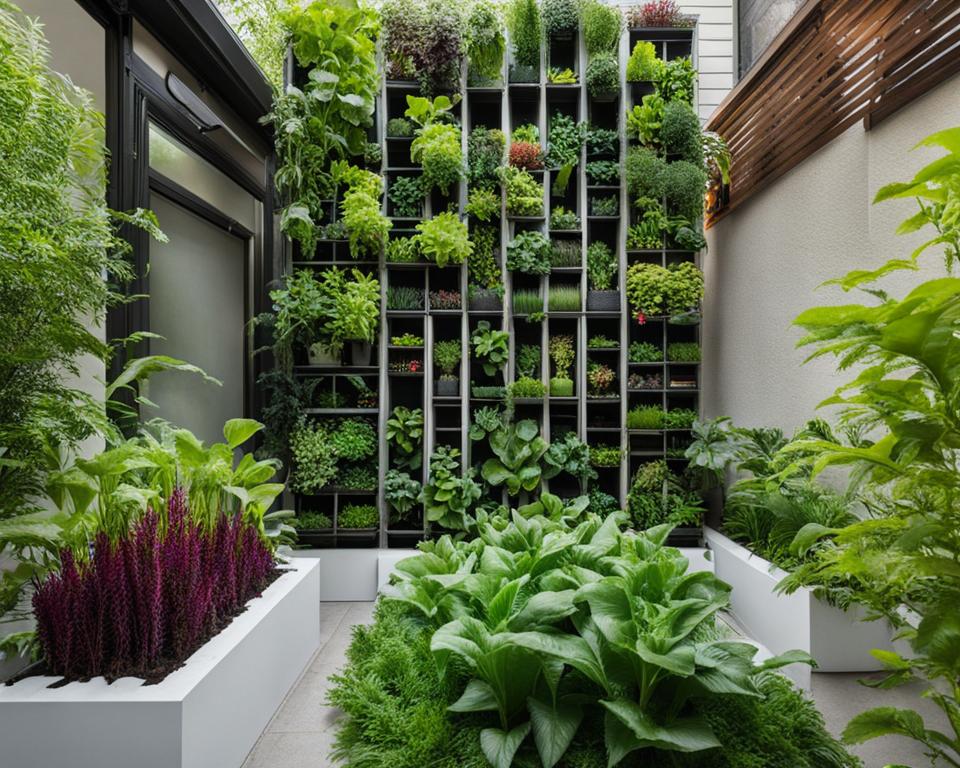
Vertical gardening offers numerous benefits for both DIY enthusiasts and urban gardeners alike. By utilizing vertical spaces, individuals with limited garden areas or small balconies can create lush green spaces and enjoy the beauty of nature in their own homes. The benefits of vertical gardening extend beyond aesthetics; they also include increased yield in limited space, improved air quality, and enhanced insulation and energy efficiency.
Maximizing Space Efficiency
One of the primary benefits of vertical gardening is its ability to maximize space efficiency. By growing plants vertically, individuals can make the most of their available space, transforming small balconies or walls into vibrant gardens. This is particularly advantageous for urban dwellers with limited outdoor spaces. Vertical gardening allows for the cultivation of a larger variety of plants, providing individuals with the opportunity to enjoy a bountiful harvest even in compact areas.
Increased Yield in Limited Space
Vertical gardening techniques optimize sunlight exposure and air circulation, resulting in healthier and more productive plants. By growing plants vertically, individuals can maximize their yield per square foot of gardening space. This is especially valuable for those with limited garden areas, as it allows them to make the most of their available resources and enjoy a plentiful harvest.
Improved Aesthetic Appeal
Vertical gardens add a stunning visual element to any space, enhancing its aesthetic appeal. The vibrant colors, varied textures, and cascading foliage of vertical gardens create a sense of tranquility and natural beauty. Whether adorning the walls of a home or providing a striking feature in a backyard, vertical gardens provide a captivating and lush backdrop that can transform any area into a serene oasis.
| Benefits of Vertical Gardening |
|---|
| Maximizes space efficiency |
| Increases yield in limited space |
| Enhances aesthetic appeal |
| Improves air quality |
| Enhances insulation and energy efficiency |
Vertical gardening offers a sustainable and visually pleasing solution for creating lush and productive gardens in small or urban environments.
Vertical gardening not only provides a way to maximize space and increase yield but also offers benefits for the environment. Vertical gardens act as natural air purifiers, contributing to better air quality by filtering pollutants and reducing airborne contaminants. Additionally, by creating a green layer on walls or structures, vertical gardens provide insulation benefits, enhancing energy efficiency and promoting a more sustainable living or working space.
With the rise of urban gardening and the increasing popularity of DIY vertical gardens, more people are discovering the numerous benefits that vertical gardening offers. Whether you’re looking to beautify your small balcony, create a vibrant green wall, or grow your own fresh produce in limited space, vertical gardening provides a practical and aesthetically pleasing solution for urban gardeners and DIY enthusiasts alike.
Maximizing Space Efficiency
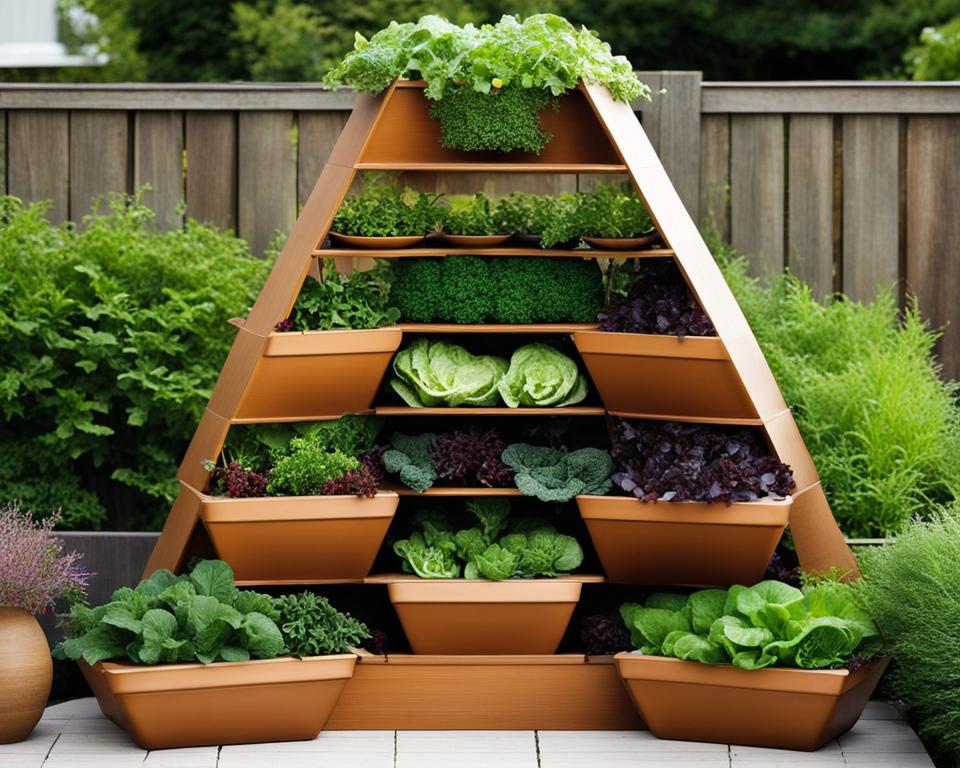
When it comes to small space gardening, vertical gardening is a game-changer. By utilizing vertical surfaces that are often overlooked, individuals can make the most of their available space and transform even the smallest balconies or walls into lush green spaces.
Vertical gardening provides a solution for those with limited garden areas or restricted outdoor spaces. It allows you to cultivate a larger variety of plants, expanding your gardening possibilities and creating a bountiful harvest.
| Benefits of Maximizing Space Efficiency |
|---|
| Utilizes vertical surfaces for gardening |
| Transforms small balconies or walls into green spaces |
| Expands gardening possibilities |
| Allows for a bountiful harvest |
Whether you’re a city dweller with limited outdoor space or simply looking to maximize the potential of your garden area, vertical gardening is the perfect solution. Embrace this technique, and watch as your small space flourishes with vibrant plants and abundant greenery.
Vertical Gardening Tips
- Choose compact plants that thrive in small spaces.
- Use vertical structures such as trellises, hanging pots, or living walls to maximize space.
- Optimize sunlight exposure by positioning your vertical garden in a spot that receives ample amounts of light.
- Ensure proper watering and drainage to keep your plants healthy.
- Consider using a combination of flowers, herbs, and vegetables to create a visually appealing and functional garden.
By following these vertical gardening tips and making the most of your available space, you can create a thriving garden even in the smallest of areas.
Increased Yield in Limited Space
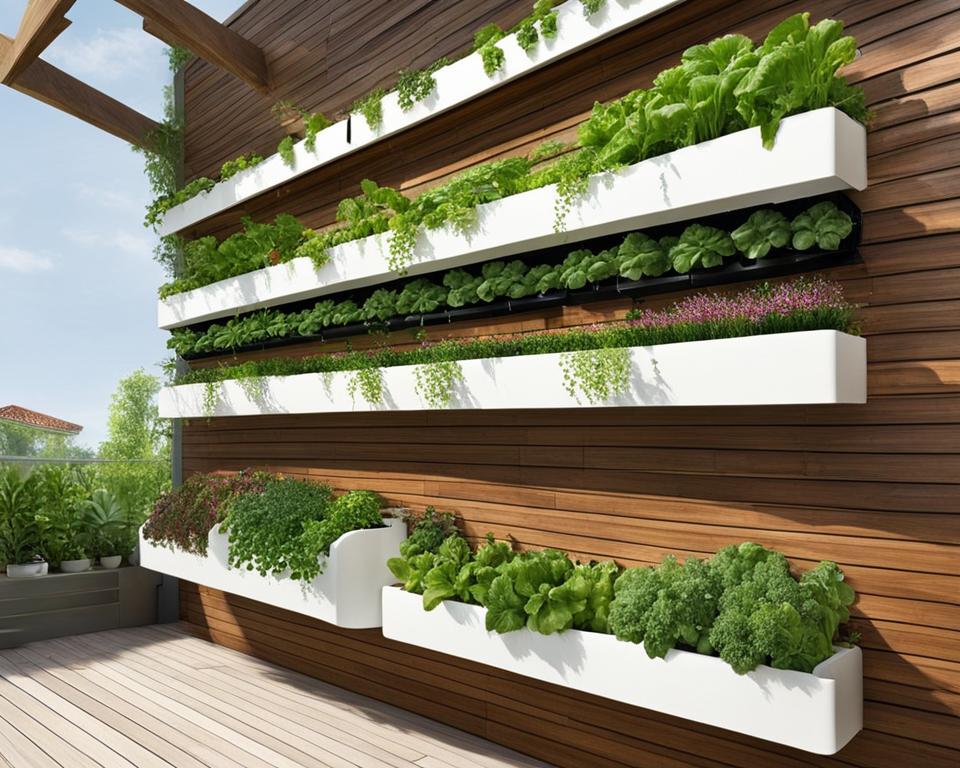
When it comes to vertical vegetable gardening, one of the key advantages is the increased yield that can be achieved in limited space. By utilizing vertical gardening techniques, individuals can optimize sunlight exposure and air circulation, resulting in healthier and more productive plants. This is particularly valuable for those with small garden areas or restricted outdoor spaces.
Vertical gardening allows for the cultivation of a larger variety of plants, even in compact areas. By growing plants vertically, individuals can maximize their yield per square foot of gardening space. This means more vegetables, herbs, and fruits can be grown and enjoyed, providing a bountiful harvest for all.
It’s important to choose suitable gardening systems for vertical vegetable gardening. Options such as trellises, wall-mounted systems, or specially designed structures can provide the stability needed to support the plants and ensure their safety. By selecting the right techniques and systems, individuals can make the most of their limited space and grow an abundant variety of crops.
Whether you’re a seasoned gardener or just starting out, vertical vegetable gardening techniques offer a practical and efficient way to maximize your yield in limited space. By embracing the possibilities of vertical gardening systems, you can transform your small garden into a thriving oasis of fresh produce.
Improved Aesthetic Appeal
Vertical gardens are not only functional but also add a touch of beauty to any space. Whether it’s the walls of your home, the backyard, or a commercial establishment, vertical gardens create a stunning visual impact. The vibrant colors, varied textures, and cascading foliage of the plants create a sense of tranquility and natural beauty.
Imagine walking into a living room adorned with a lush green wall, or sitting in a restaurant surrounded by a vertical garden. These visually striking features not only captivate the eye but also create a calming and inviting atmosphere. Vertical gardens serve as living artworks, bringing nature indoors and turning any space into a green oasis.
Moreover, vertical gardens offer endless possibilities for creativity and personalization. You can choose from a wide variety of plant species, mix and match colors and textures, and experiment with different layouts. Whether you prefer a symmetrical design or a more organic look, vertical gardening allows you to express your style and create a unique and personalized space.
| Benefits | Examples |
|---|---|
| Enhanced visual appeal | A living wall in a contemporary office space |
| Improved ambiance | A vertical garden in a restaurant patio area |
| Relaxing and inviting atmosphere | A vertical garden in a hotel lobby |
So, whether you have a small balcony, a blank wall, or a limited outdoor space, vertical gardening is a fantastic way to transform your surroundings into a visually stunning and lush environment. Let your imagination run wild, and create your own vertical garden masterpiece!
Testimonial:
“I absolutely love my vertical garden! It has completely transformed my backyard. The vibrant colors and cascading foliage create a serene and peaceful atmosphere. It’s like having my own private oasis!” – Jane Doe, Vertical Gardening Enthusiast
Better Air Quality
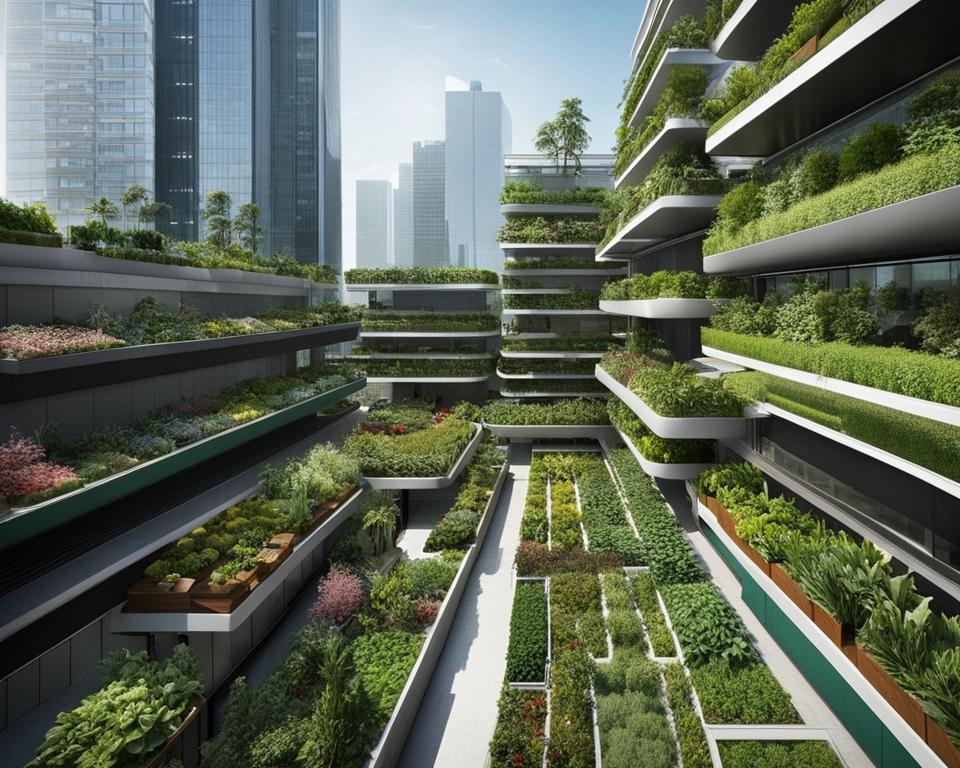
Vertical gardens not only enhance the aesthetic appeal of a space but also have a positive impact on air quality. Through the process of photosynthesis, plants in vertical gardens absorb carbon dioxide and release oxygen, which helps create a healthier and more oxygen-rich environment. By incorporating vertical gardens into our urban spaces, we can contribute to improving the overall air quality for ourselves and future generations.
One of the main benefits of vertical gardens in urban settings is their ability to act as natural air purifiers. The plants in vertical gardens help filter pollutants and reduce airborne contaminants, such as dust and chemicals, thus promoting a cleaner and fresher atmosphere. This is especially beneficial for individuals living in densely populated areas where air pollution can be a concern.
“Vertical gardens not only enhance the aesthetic appeal of a space but also have a positive impact on air quality.”
Furthermore, vertical gardens can help mitigate the effects of urban heat islands, which are areas that experience higher temperatures due to the concentration of buildings and pavement. By adding a layer of greenery to vertical surfaces, these gardens act as natural insulation and reduce heat gain in summers, leading to a cooler environment. This can help reduce the energy demand for cooling and contribute to energy savings.
In conclusion, vertical gardens play a significant role in improving air quality in urban environments. They act as natural air purifiers, filter pollutants, and reduce airborne contaminants, creating a cleaner and fresher atmosphere. Additionally, vertical gardens contribute to insulation and energy efficiency, making them a sustainable and eco-friendly solution. By incorporating vertical gardening tips into our urban spaces, we can create a greener and healthier environment for ourselves and future generations.
Benefits of Vertical Gardens on Air Quality:
- Acts as natural air purifiers
- Filters pollutants and reduces airborne contaminants
- Reduces the effects of urban heat islands
- Improves overall air quality in urban environments
Table: Comparison of Vertical Gardens with Traditional Gardens
| Factors | Vertical Gardens | Traditional Gardens |
|---|---|---|
| Space Efficiency | Maximizes space by growing plants vertically | Requires more horizontal space |
| Yield | Optimizes sunlight exposure and air circulation, resulting in increased yield | May have limitations due to available space |
| Aesthetic Appeal | Adds a stunning visual element to any space | Depends on the design and maintenance of the garden |
| Air Quality | Acts as natural air purifiers, filtering pollutants | Has limited impact on air quality |
| Insulation and Energy Efficiency | Offers insulation benefits and contributes to energy savings | May not have a significant impact on insulation and energy efficiency |
Enhanced Insulation and Energy Efficiency
Vertical gardens not only bring beauty and greenery to our surroundings, but they also offer practical benefits such as enhanced insulation and improved energy efficiency. These gardens act as natural barriers against extreme temperatures, providing additional insulation by creating a green layer on walls or structures. This natural insulation helps to reduce heat gain during the hot summer months and minimize heat loss during chilly winters, resulting in energy savings and enhanced energy efficiency.
By incorporating vertical gardens into our living or working spaces, we can create a more sustainable environment. The insulation benefits offered by these gardens contribute to lowering energy consumption, thus reducing our carbon footprint. With the increasing focus on eco-friendly practices, vertical gardening systems provide a practical solution for individuals looking to make their homes and workplaces more energy-efficient.
Additionally, vertical gardens offer aesthetic appeal, making them a popular choice for both residential and commercial spaces. The lush greenery and cascading foliage create a tranquil ambiance while simultaneously providing insulation benefits. These gardens not only improve the visual appeal of a space but also contribute to a more comfortable and eco-conscious environment.
The Role of Vertical Gardening Systems in Energy Efficiency
Vertical gardening systems have a significant impact on energy efficiency in multiple ways:
- Insulation: Vertical gardens act as a natural insulator, providing an additional layer of protection against heat and cold.
- Shade and Cooling: The dense foliage of vertical gardens creates shade, reducing the amount of direct sunlight that enters a building and helping to cool the surrounding area.
- Reduced Air Conditioning Needs: With their cooling effect, vertical gardens can help reduce the reliance on air conditioning systems, resulting in lower energy consumption.
- Improved Air Quality: Vertical gardens act as natural air purifiers, filtering out pollutants and improving indoor air quality.
Investing in a vertical gardening system not only enhances the visual appeal of a space but also contributes to a more sustainable and energy-efficient lifestyle. By creating a natural barrier against extreme temperatures and providing insulation benefits, vertical gardens offer a practical solution for individuals looking to reduce energy consumption and create a greener environment.
Conclusion
In conclusion, vertical vegetable gardening systems are a game-changer for individuals with limited gardening areas or small outdoor spaces. The concept of vertical gardening offers a sustainable and visually pleasing solution for creating lush and productive gardens even in small or urban environments.
By utilizing vertical surfaces and growing plants vertically, individuals can maximize space efficiency and make the most of their available space. This is particularly beneficial for small space gardening, allowing individuals to cultivate a larger variety of plants and enjoy a bountiful harvest.
Vertical gardening systems not only provide practical benefits but also enhance the aesthetic appeal of any space. The vibrant colors, varied textures, and cascading foliage of vertical gardens create a sense of tranquility and natural beauty.
Furthermore, vertical gardening contributes to improved air quality by absorbing carbon dioxide and releasing oxygen. It also aids in filtering pollutants, promoting a cleaner and fresher atmosphere. In addition, vertical gardens act as natural barriers against extreme temperatures, enhancing insulation and energy efficiency in living or working spaces.
FAQ
What is vertical gardening?
Vertical gardening is a unique gardening technique that involves growing plants vertically, either on walls, fences, or specially designed structures. It maximizes space utilization, making it ideal for those with limited garden areas or urban dwellers with restricted outdoor spaces.
How do I create a vertical garden?
To create a vertical garden, it is important to choose the right location that receives sufficient sunlight throughout the day. Select suitable plants based on their light, moisture, and temperature requirements. Building a sturdy support structure, such as trellises or wall-mounted systems, is essential. This ensures the stability of the vertical garden and the safety of the plants.
What are the benefits of vertical gardening?
Vertical gardening offers numerous benefits. It maximizes space efficiency, allowing individuals with limited garden areas or small balconies to create lush green spaces. It also increases yield in limited space by optimizing sunlight exposure and air circulation. Vertical gardens add aesthetic appeal to any space, providing a vibrant and natural backdrop. Additionally, vertical gardens contribute to better air quality by acting as natural air purifiers and can enhance the insulation and energy efficiency of living or working spaces.
How does vertical gardening maximize space efficiency?
Vertical gardening allows individuals to make the most of their available space by utilizing vertical surfaces that are often overlooked. This is particularly advantageous for those with limited garden areas or restricted outdoor spaces. By growing plants vertically, even small balconies or walls can be transformed into lush green spaces. Vertical gardening provides a solution to limited gardening areas, allowing individuals to cultivate a larger variety of plants and enjoy a bountiful harvest.
Does vertical gardening increase the yield in limited space?
Yes, vertical gardening enables individuals to maximize their yield per square foot of gardening space. By growing plants vertically, they can optimize sunlight exposure and air circulation, resulting in healthier and more productive plants. Even in compact areas, vertical gardening allows for the cultivation of a larger variety of plants and the enjoyment of a bountiful harvest.
How does vertical gardening enhance aesthetic appeal?
Vertical gardens add a stunning visual element to any space. Whether adorning the walls of a home, creating a striking feature in a backyard, or enhancing the ambiance of a commercial establishment, vertical gardens provide a captivating and lush backdrop. The vibrant colors, varied textures, and cascading foliage of vertical gardens create a sense of tranquility and natural beauty.
How does vertical gardening improve air quality?
Vertical gardens contribute to improving air quality in both indoor and outdoor settings. Through photosynthesis, plants in vertical gardens absorb carbon dioxide and release oxygen, creating a healthier and more oxygen-rich environment. Vertical gardens also aid in filtering pollutants and reducing airborne contaminants, promoting a cleaner and fresher atmosphere.
How does vertical gardening enhance insulation and energy efficiency?
Vertical gardens offer insulation benefits by acting as a natural barrier against extreme temperatures. They provide additional insulation by creating a green layer on walls or structures. This natural insulation reduces heat gain in summers and heat loss in winters, leading to energy savings and enhanced energy efficiency. By creating a more insulated environment, vertical gardens contribute to a more sustainable and eco-friendly living or working space.

